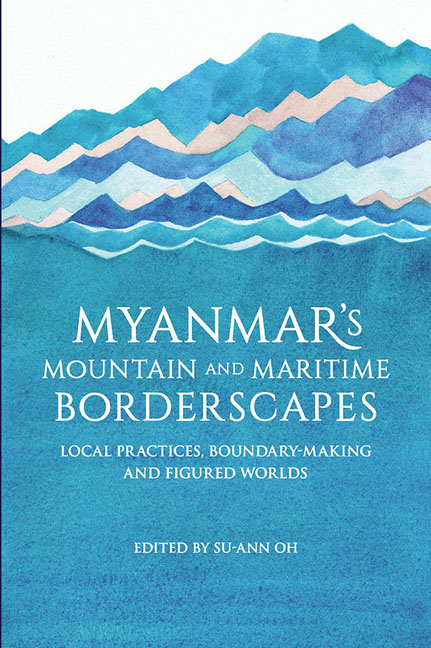Book contents
- Frontmatter
- Contents
- List of Tables
- List of Figures
- Acknowledgements
- Notes on Language, Terminology and Geographical Names
- Contributors
- Abbreviations
- 1 Introduction
- I Overview of Myanmar's Mountain and Maritime Borderscapes
- II Territorial Claims and Imagined Boundaries
- 4 Burman Territories and Borders in the Making of a Myanmar Nation State
- 5 Ritual and the Other in Rakhine Spirit Cults
- 6 Rohingya Territoriality in Myanmar and Bangladesh: Humanitarian Crisis and National Disordering
- III Social Organization and Border Economies
- IV Mobile Practices and Moving Borders
- V Identity Construction and the Politics of Belonging
- VI Institutionalized Identity and Border Practices
- Index
5 - Ritual and the Other in Rakhine Spirit Cults
from II - Territorial Claims and Imagined Boundaries
Published online by Cambridge University Press: 06 June 2017
- Frontmatter
- Contents
- List of Tables
- List of Figures
- Acknowledgements
- Notes on Language, Terminology and Geographical Names
- Contributors
- Abbreviations
- 1 Introduction
- I Overview of Myanmar's Mountain and Maritime Borderscapes
- II Territorial Claims and Imagined Boundaries
- 4 Burman Territories and Borders in the Making of a Myanmar Nation State
- 5 Ritual and the Other in Rakhine Spirit Cults
- 6 Rohingya Territoriality in Myanmar and Bangladesh: Humanitarian Crisis and National Disordering
- III Social Organization and Border Economies
- IV Mobile Practices and Moving Borders
- V Identity Construction and the Politics of Belonging
- VI Institutionalized Identity and Border Practices
- Index
Summary
CONTEXT
In June 2012, the Rakhine State (Arakan) was the scene of violent conflict between Buddhists and Muslims. Ever since then, there have been other outbreaks of violence with attacks on mosques and Muslim-owned houses in different parts of the region, notably in Mrauk U, around the town of Thandwe, Yangon and Meiktilla.
This conflict in Rakhine State raises the question of “strangeness” in the sense of belonging to groups at the margins of society, or of being an outsider. I will attempt here to provide an interpretation of the Rakhine concept of the strangeness of the outsider in relation to rituals dedicated to spirits.
Mrauk U is considered by the Rakhine as their cultural and historical heartland. Shortly after the outbreak of the events in Rakhine State, many inhabitants took part in a ceremony whose purpose was to relocate the statue of the palace guardian spirit so that the image faced the West, in the direction of the enemy. Also, many of the inhabitants whose houses had not caught fire in the course of the confrontations that spread through Sittwe (June/July 2012), the capital of Rakhine State, claimed that the guardian spirit of the town had protected them from the flames and from the enemy. This chapter will consider the conflict from the perspective of ritual.
Focusing on ritual is important. I have previously demonstrated how the former Burmese authorities in Rakhine State have relied on spirit cults, to exercise political control over the state (see de Mersan 2009, pp. 319–20, 323–26). In today's context of violence, rituals also allow us to take a step back so as to better understand the situation. Based on the assumption that there is a direct link between rituals and the society that develops them, my main question is “What do rituals have to say about the current social and political situation?”. As we shall see with territorial cults, rituals are expressions of social relationships based on territory between different communities.
DIFFERENT NAMES FOR THE MUSLIMS OF RAKHINE STATE
Based on fifteen years of anthropological research in and on Rakhine State (see de Mersan 2005, 2009, 2010, 2012), this chapter reflects, above all, the points of view and beliefs of the Rakhine, a term which nowadays mostly means the Buddhist Rakhine.
- Type
- Chapter
- Information
- Myanmar's Mountain and Maritime BorderscapesLocal Practices, Boundary-Making and Figured Worlds, pp. 121 - 145Publisher: ISEAS–Yusof Ishak InstitutePrint publication year: 2016

